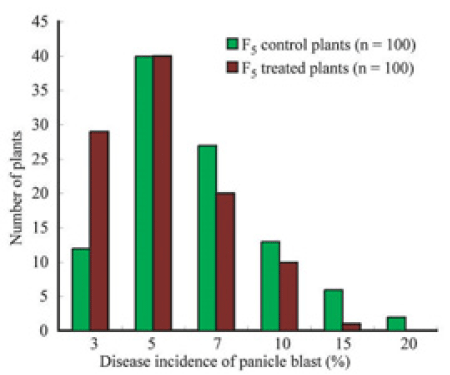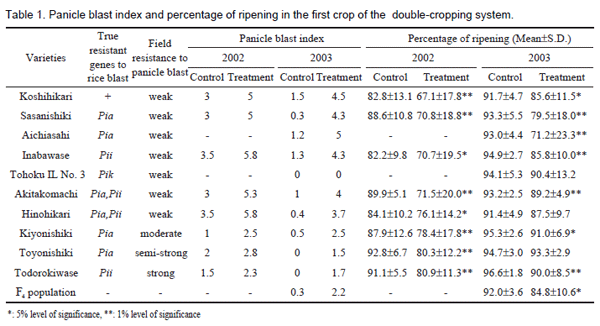Eliminating weak panicle blast field resistant plants from a rice hybrid population during rapid generation advancement
Description
Panicle blast can damage both the yield and grain quality of rice. It is therefore important to develop panicle blast field resistant varieties in an efficient manner. JIRCAS’s Okinawa Subtropical Station has a Rice Rapid Generation Advancement Program in which rice hybrid populations are cropped two or three times per year. If it is possible to eliminate weak panicle blast field resistant plants from a rice hybrid population during rapid generation advancement, varieties with panicle blast resistance can be developed more efficiently. In the Station fields, panicle blast infection rates are unreliable, making it necessary to establish cultivation conditions that guarantee infection with panicle blast.
In the first crop in a double-cropping system, we researched the following three treatments in an attempt to ensure infection with panicle blast as follows: 1) The nitrogen content of the basal fertilizer of the treatment field was raised to 2 kg/10 a more than the controls, and ammonium sulfate was additionally applied at rates 3-4 times the control, 2) water was sprinkled over the treatment field for about an hour every morning and evening, and 3) the treatment field was surrounded with cheesecloth.
In the treatment field, the panicle blast index of both tested varieties and the F4 population was higher than in the control field (Table 1). Moreover, the percentage of ripening of both tested varieties and F4 population was significantly lower than the controls (Table 1). The percentage of ripening of the tested weak varieties was lower than that of the moderate and strong varieties (Table 1). The F5 population cultivated under the treatment conditions in F4 showed fewer plants with high disease incidence than did the F5 population cultivated under the control conditions in F4 (Fig. 1).
The cultivation conditions were established to achieve reliable infection with panicle blast in the first crop of the double cropping system. It was shown that cultivation of a rice hybrid population under conditions that make it more sensitive to panicle blast infection effectively allows identification and removal of the weakly resistant plants before the next generation.
Figure, table
-
Fig. 1. Frequency distribution of disease incidence of panicle blast in F5 plants cultivated from the F4 hybrid population in control and treatment fields.
(Data from the Rice Breeding Laboratory, National Agricultural Research Center for Tohoku Region) -
- Affiliation
-
Japan International Research Center for Agricultural Sciences Okinawa Subtropical Station
- Classification
-
Technical A
- Term of research
-
FY2004(FY2002~2005)、FY2004(FY2003~2005)
- Responsible researcher
-
TAMURA Yasuaki ( Okinawa Subtropical Station )
SATO Mitsunori ( Okinawa Subtropical Station )
TANIO Masahiko ( Okinawa Subtropical Station )
ISHIKI Koshun ( Okinawa Subtropical Station )
MATSUOKA Makoto ( Agriculture, Forestry and Fisheries Research Council Secretariat, Ministry of Agriculture, Forestry and Fisheries )
YAMAGUCHI Masayuki ( Tohoku Agricultural Research Center, NARO )
TAKAGI Hiroko ( Okinawa Subtropical Station )
- ほか
- Publication, etc.
-
Tamura,Y., M. Tanio, M. Sato, Efendi, K. Ishiki, H. Takagi and M. Matsuoka.(2004): Development of screening method to eliminate plants with low field resistance to panicle blast from hybrid population during rapid generation advancement. Abstract for World Rice Research Conference, 360
- Japanese PDF
-
2004_20_A3_ja.pdf795.16 KB


